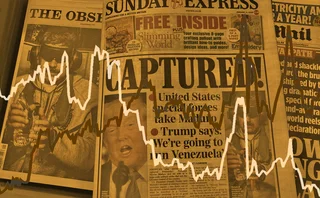

The squeezing middle: data shows Europeans taking on US foes
Dealer Rankings 2024: Barclays, BNP Paribas and Deutsche grab bigger share of the pie
This article is an introduction to our Dealer Rankings 2024 coverage. You can find detailed analysis of the top 10 dealers here, and of the market for each instrument here. A detailed methodology is also available.
There are a host of stories – big and small – in our second Dealer Rankings, but one of the most interesting can be found right at the top of the pile, in the overall top 10. It’s the story of a squeeze.
Those doing the squeezing are Barclays, BNP Paribas, and Deutsche Bank – the banks that sit in places six, seven and eight, the exact ones they occupied last year. Those getting squeezed are the firms on either side.
But it’s a story that takes some explaining.
The overall table reflects the positions of dealers across the various instruments reported by US mutual funds and ETFs, and by US life insurers whose regulatory disclosures and underlying data are collected and aggregated by Risk.net’s Counterparty Radar service. It treats all instruments equally, with no weighting for the importance of that market. If a dealer is top of the pile for equity index options with insurers, then they get 10 points; the second-placed dealer gets nine, and so on.
Exactly the same would be true for repo trades with mutual funds or for index credit default swaps with insurers – in fact, for any of the 16 combinations of instrument and client type. All of these points are aggregated, to create the overall rankings table.
Mini-methodology
When reading, it will help to bear the following points in mind. A full description of the methodology is available here.
- The rankings are based on quarterly, trade-level snapshots of derivatives positions filed by mutual funds and life insurers, complete with the sell-side counterparty for each trade.
- For each instrument, and each end-user type, the data has been sliced into dozens of cuts – for example, all trades, large trades, long-dated trades, popular underlyings.
- Dealers active in each of these cuts are ranked in six ways – by total notional (or book size), by number of tickets, by number of clients, and by year-on-year growth in each of this first trio.
- Points are awarded based on how many dealers each firm finishes ahead of – there are more points on offer in well-populated cuts of the data.
- Collectively, we refer to points for notional, tickets and clients as ‘gross points’. We refer to points for year-on-year changes as ‘increase points’.
Last year’s inaugural Dealer Rankings identified a ‘big eight’ – the five US and three European banks that lock horns in almost all of the derivatives products covered by the rankings. Beyond these eight names was a long tail of dealers with more spotty ambitions – strong in some places, but not in many.
At first glance, not much has changed in the latest year’s batch of data. The same eight names appear at the top of the list. The five US banks lead the way again – with Citi on top, dethroning Morgan Stanley – and the three Europeans tuck in behind. The latter even occupy exactly the same positions, despite a rejig among the top five.
When you look at the points totals amassed by each, though, this familiar picture takes on a different hue.
In last year’s rankings, the top five dealers all finished with a haul of more than 100 points. Morgan Stanley, at the top, had 114; Bank of America, in fifth, had 105. That’s a 9% spread. Really, you could have thrown a beach towel over the lot.
This year, only the top three passed the 100-point mark – and a tea-towel would suffice as cover. Citi finished top with 109; JP Morgan was third with 106.
The other difference is what happens behind that initial pack. Last year, there was a big drop from the US to the European dealers, and big gaps between each of the Europeans. Behind BofA’s 105, Barclays had 84, BNP Paribas 64, Deutsche Bank 50.
This year, Goldman Sachs and Morgan Stanley are tied on 97 points, with Barclays on 93, BNP Paribas on 85, and Deutsche on 55.
All three of the Europeans improved on last year’s points tally, with Barclays and BNP Paribas, in particular, taking big strides. They are reeling in the hindmost US banks, as the chart below demonstrates.
The European trio is the only group of dealers in the overall top 10 that increased its points share when compared to last year. The top five US banks now have 65% of the points, down from 69%. The Europeans jump to 29% from 25%. And the two banks that sit outside the big eight (this year Wells Fargo and UBS; last year Credit Suisse and HSBC) have only 5% of the top 10 points tally, versus 6% last year.
Abstract concrete
This is, of course, an abstraction: the overall table is a ranking of rankings. But it is derived from concrete, tangible things.
Let’s look at some. BNP Paribas gains some of its additional points this year from an improved ranking in interest rate swaps with life insurers, where it jumped from eighth last year to first this time round. The French dealer had a bigger aggregate book than Morgan Stanley and was named as a counterparty for more tickets than JP Morgan. For super-long-dated trades, it added more clients than Goldman Sachs. For SOFR-referencing trades, it was named on more trades than either Goldman or Morgan Stanley. And so on.
Each of these small (but solid) achievements contributes to the French bank’s standing in insurer swaps, feeding through to its position in the overall ranking. It also nibbles away at the points the big US banks were able to gain. This is what the squeeze looks like in practice.
Another example can be seen in swaptions with mutual funds and exchange-traded funds, where Barclays finished tenth last year, and leapt to third this year – so, adding eight points to its overall ranking, rather than the single point it collected last time.
The UK dealer has a smaller book, fewer tickets, and fewer clients than its US rivals. But it was on the march last year, according to client filings – beating all of the big five US banks in notional and client growth, and increasing tickets by more than any bank except JP Morgan.
The goal of the Dealer Rankings is to turn these little vignettes – buried in thousands of regulatory filings – into a representation of the over-the-counter derivatives market’s hidden cut-and-thrust. Changing patterns of client demand, shifting bilateral relationships, sell-side firms pushing ahead or beating a retreat.
Two notes of caution, though. While the rankings help tell a story about who is trading with whom, and how those relationships are changing – about footprint and momentum, essentially – they say nothing about whether those trades are making money. As a rule, the European dealers improved in this year’s rankings primarily by outgrowing some of their rivals. Book sizes, tickets and client rosters increased. But it’s easy to ‘buy’ growth in OTC markets, and much harder to hold on to it.
And it’s critically important to understand the methodology behind all of these tables. Everything is derived from regulatory filings, but the data has to be cleaned, and decisions have to be made about how to cut it up and stitch it back together. This is something we try to be transparent about. You can find a trimmed-down version of the methodology alongside this article, but we recommend taking the time to read the full-fat version here.
Editing by Michael Paterakis
Only users who have a paid subscription or are part of a corporate subscription are able to print or copy content.
To access these options, along with all other subscription benefits, please contact info@risk.net or view our subscription options here: http://subscriptions.risk.net/subscribe
You are currently unable to print this content. Please contact info@risk.net to find out more.
You are currently unable to copy this content. Please contact info@risk.net to find out more.
Copyright Infopro Digital Limited. All rights reserved.
As outlined in our terms and conditions, https://www.infopro-digital.com/terms-and-conditions/subscriptions/ (point 2.4), printing is limited to a single copy.
If you would like to purchase additional rights please email info@risk.net
Copyright Infopro Digital Limited. All rights reserved.
You may share this content using our article tools. As outlined in our terms and conditions, https://www.infopro-digital.com/terms-and-conditions/subscriptions/ (clause 2.4), an Authorised User may only make one copy of the materials for their own personal use. You must also comply with the restrictions in clause 2.5.
If you would like to purchase additional rights please email info@risk.net
More on Markets
Trump’s LatAm gambit spurs FX hedging rush
Venezuela op boosts risk reversals as investors look to protect carry trades
One Trading brings 24/7 equity trading to Europe
Start-up exchange will launch perpetual futures Clob in Q1 after AFM nod
FXGO volumes surge despite fee switch-on
Dealers split on whether levy is behind volume increases across SDPs
Banks hope new axe platform will cut bond trading costs
Dealer-backed TP Icap venture aims to disrupt dominant trio of Bloomberg, MarketAxess and Tradeweb
Kyriba sees uptake in AI-assisted FX hedging tools
Automated data collection and cleaning helps corporates create better hedges and has cut unexplained P&L moves by 87%, says vendor
Review of 2025: It’s the end of the world, and it feels fine
Markets proved resilient as Trump redefined US policies – but questions are piling up about 2026 and beyond
Does crypto really need T+0 for everything?
Instant settlement brings its own risks but doesn’t need to be the default, writes BridgePort’s Soriano
Asset managers prep autocall ETFs with assets tipped to hit $30bn
Actively managed strategies wait in the wings after systematic approach nets Calamos $500m








